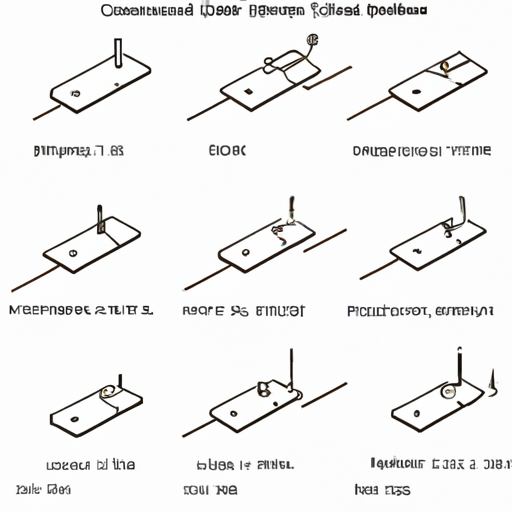Popular Models of Common Capacitor Voltages

I. Introduction
Capacitors are fundamental components in electronic circuits, serving as energy storage devices that can release energy when needed. They play a crucial role in various applications, from smoothing out voltage fluctuations in power supplies to filtering signals in audio equipment. Understanding the voltage ratings of capacitors is essential for selecting the right component for a specific application. This article will explore common capacitor voltages, their types, popular models, and factors influencing voltage selection.
II. Understanding Capacitor Voltage Ratings
A. Explanation of Voltage Rating
The voltage rating of a capacitor indicates the maximum voltage that can be applied across its terminals without risking failure. Exceeding this voltage can lead to dielectric breakdown, resulting in catastrophic failure, which may include leakage, explosion, or complete failure of the capacitor. Therefore, understanding voltage ratings is critical for ensuring the longevity and reliability of electronic devices.
B. Common Voltage Ratings in Capacitors
Capacitors are categorized based on their voltage ratings:
1. **Low Voltage (up to 50V)**: These capacitors are commonly used in low-power applications, such as consumer electronics and small signal circuits.
2. **Medium Voltage (50V to 250V)**: This range is typical for industrial applications, power supplies, and audio equipment.
3. **High Voltage (250V and above)**: High-voltage capacitors are used in specialized applications, including power transmission and high-frequency circuits.
III. Types of Capacitors and Their Voltage Ratings
A. Ceramic Capacitors
Ceramic capacitors are widely used due to their small size, low cost, and stability. They are available in various voltage ratings, typically ranging from 6.3V to 1000V. Common applications include decoupling, filtering, and timing circuits.
B. Electrolytic Capacitors
Electrolytic capacitors are polarized components known for their high capacitance values. They are commonly rated between 6.3V and 450V. These capacitors are often used in power supply circuits, audio amplifiers, and energy storage applications.
C. Film Capacitors
Film capacitors are known for their reliability and low loss characteristics. They typically have voltage ratings ranging from 50V to 1000V. Common applications include audio equipment, power electronics, and timing circuits.
D. Tantalum Capacitors
Tantalum capacitors are known for their high capacitance in a small package. They are usually rated between 6.3V and 50V. These capacitors are commonly used in portable electronics, medical devices, and military applications.
E. Supercapacitors
Supercapacitors, or ultracapacitors, are designed for high energy storage and rapid charge/discharge cycles. They typically have voltage ratings ranging from 2.5V to 5.5V. Common applications include energy storage systems, backup power supplies, and regenerative braking systems.
IV. Popular Models of Capacitors by Voltage Rating
A. Capacitors Rated for 10V to 50V
In this range, capacitors are often used in consumer electronics and low-power applications. Popular models include:
Panasonic ECQ Series: These film capacitors are known for their reliability and are available in various capacitance values.
Nichicon UHE Series: These electrolytic capacitors are designed for low impedance and high ripple current applications.
B. Capacitors Rated for 50V to 100V
Capacitors in this range are commonly used in power supplies and audio applications. Notable models include:
Kemet C4AE Series: These ceramic capacitors offer high capacitance and low ESR, making them suitable for power supply decoupling.
Rubycon ZLJ Series: These electrolytic capacitors are designed for high ripple current and long life, ideal for audio amplifiers.
C. Capacitors Rated for 100V to 250V
Capacitors in this category are often used in industrial applications. Popular models include:
WIMA MKS Series: These film capacitors are known for their high voltage ratings and stability, making them suitable for power electronics.
Nichicon PW Series: These electrolytic capacitors are designed for high performance in power supply applications.
D. Capacitors Rated for 250V and Above
High-voltage capacitors are used in specialized applications. Notable models include:
Vishay BC Components 193 Series: These film capacitors are designed for high voltage and high-frequency applications.
KEMET T520 Series: These tantalum capacitors are rated for high voltage and are used in military and aerospace applications.
V. Factors Influencing Capacitor Voltage Selection
A. Application Requirements
When selecting a capacitor, it is essential to consider the specific requirements of the application. This includes circuit design considerations, such as the maximum voltage the capacitor will experience, and load conditions, which can affect the capacitor's performance.
B. Environmental Factors
Environmental conditions, such as temperature and humidity, can significantly impact capacitor performance. High temperatures can reduce the lifespan of capacitors, while humidity can lead to corrosion and failure. Mechanical stress, such as vibration or shock, can also affect the reliability of capacitors.
C. Safety Margins
It is crucial to incorporate safety margins when selecting voltage ratings. Derating, or selecting a capacitor with a voltage rating higher than the maximum expected voltage, is a common practice to enhance reliability. Guidelines suggest derating by 20% to 50% to account for variations in operating conditions.
VI. Conclusion
Understanding capacitor voltage ratings is vital for selecting the right component for electronic applications. This article has explored the different types of capacitors, their voltage ratings, and popular models across various voltage ranges. By considering application requirements, environmental factors, and safety margins, engineers and designers can make informed decisions to ensure the reliability and longevity of their electronic devices.
VII. References
1. "Capacitor Basics: Types, Ratings, and Applications." Electronics Tutorials.
2. "Understanding Capacitor Voltage Ratings." Digi-Key Electronics.
3. Manufacturer datasheets for Panasonic, Nichicon, Kemet, Rubycon, Vishay, and KEMET capacitors.
By understanding the nuances of capacitor voltage ratings and the various models available, you can ensure that your electronic designs are both effective and reliable.
Popular Models of Common Capacitor Voltages

I. Introduction
Capacitors are fundamental components in electronic circuits, serving as energy storage devices that can release energy when needed. They play a crucial role in various applications, from smoothing out voltage fluctuations in power supplies to filtering signals in audio equipment. Understanding the voltage ratings of capacitors is essential for selecting the right component for a specific application. This article will explore common capacitor voltages, their types, popular models, and factors influencing voltage selection.
II. Understanding Capacitor Voltage Ratings
A. Explanation of Voltage Rating
The voltage rating of a capacitor indicates the maximum voltage that can be applied across its terminals without risking failure. Exceeding this voltage can lead to dielectric breakdown, resulting in catastrophic failure, which may include leakage, explosion, or complete failure of the capacitor. Therefore, understanding voltage ratings is critical for ensuring the longevity and reliability of electronic devices.
B. Common Voltage Ratings in Capacitors
Capacitors are categorized based on their voltage ratings:
1. **Low Voltage (up to 50V)**: These capacitors are commonly used in low-power applications, such as consumer electronics and small signal circuits.
2. **Medium Voltage (50V to 250V)**: This range is typical for industrial applications, power supplies, and audio equipment.
3. **High Voltage (250V and above)**: High-voltage capacitors are used in specialized applications, including power transmission and high-frequency circuits.
III. Types of Capacitors and Their Voltage Ratings
A. Ceramic Capacitors
Ceramic capacitors are widely used due to their small size, low cost, and stability. They are available in various voltage ratings, typically ranging from 6.3V to 1000V. Common applications include decoupling, filtering, and timing circuits.
B. Electrolytic Capacitors
Electrolytic capacitors are polarized components known for their high capacitance values. They are commonly rated between 6.3V and 450V. These capacitors are often used in power supply circuits, audio amplifiers, and energy storage applications.
C. Film Capacitors
Film capacitors are known for their reliability and low loss characteristics. They typically have voltage ratings ranging from 50V to 1000V. Common applications include audio equipment, power electronics, and timing circuits.
D. Tantalum Capacitors
Tantalum capacitors are known for their high capacitance in a small package. They are usually rated between 6.3V and 50V. These capacitors are commonly used in portable electronics, medical devices, and military applications.
E. Supercapacitors
Supercapacitors, or ultracapacitors, are designed for high energy storage and rapid charge/discharge cycles. They typically have voltage ratings ranging from 2.5V to 5.5V. Common applications include energy storage systems, backup power supplies, and regenerative braking systems.
IV. Popular Models of Capacitors by Voltage Rating
A. Capacitors Rated for 10V to 50V
In this range, capacitors are often used in consumer electronics and low-power applications. Popular models include:
Panasonic ECQ Series: These film capacitors are known for their reliability and are available in various capacitance values.
Nichicon UHE Series: These electrolytic capacitors are designed for low impedance and high ripple current applications.
B. Capacitors Rated for 50V to 100V
Capacitors in this range are commonly used in power supplies and audio applications. Notable models include:
Kemet C4AE Series: These ceramic capacitors offer high capacitance and low ESR, making them suitable for power supply decoupling.
Rubycon ZLJ Series: These electrolytic capacitors are designed for high ripple current and long life, ideal for audio amplifiers.
C. Capacitors Rated for 100V to 250V
Capacitors in this category are often used in industrial applications. Popular models include:
WIMA MKS Series: These film capacitors are known for their high voltage ratings and stability, making them suitable for power electronics.
Nichicon PW Series: These electrolytic capacitors are designed for high performance in power supply applications.
D. Capacitors Rated for 250V and Above
High-voltage capacitors are used in specialized applications. Notable models include:
Vishay BC Components 193 Series: These film capacitors are designed for high voltage and high-frequency applications.
KEMET T520 Series: These tantalum capacitors are rated for high voltage and are used in military and aerospace applications.
V. Factors Influencing Capacitor Voltage Selection
A. Application Requirements
When selecting a capacitor, it is essential to consider the specific requirements of the application. This includes circuit design considerations, such as the maximum voltage the capacitor will experience, and load conditions, which can affect the capacitor's performance.
B. Environmental Factors
Environmental conditions, such as temperature and humidity, can significantly impact capacitor performance. High temperatures can reduce the lifespan of capacitors, while humidity can lead to corrosion and failure. Mechanical stress, such as vibration or shock, can also affect the reliability of capacitors.
C. Safety Margins
It is crucial to incorporate safety margins when selecting voltage ratings. Derating, or selecting a capacitor with a voltage rating higher than the maximum expected voltage, is a common practice to enhance reliability. Guidelines suggest derating by 20% to 50% to account for variations in operating conditions.
VI. Conclusion
Understanding capacitor voltage ratings is vital for selecting the right component for electronic applications. This article has explored the different types of capacitors, their voltage ratings, and popular models across various voltage ranges. By considering application requirements, environmental factors, and safety margins, engineers and designers can make informed decisions to ensure the reliability and longevity of their electronic devices.
VII. References
1. "Capacitor Basics: Types, Ratings, and Applications." Electronics Tutorials.
2. "Understanding Capacitor Voltage Ratings." Digi-Key Electronics.
3. Manufacturer datasheets for Panasonic, Nichicon, Kemet, Rubycon, Vishay, and KEMET capacitors.
By understanding the nuances of capacitor voltage ratings and the various models available, you can ensure that your electronic designs are both effective and reliable.













